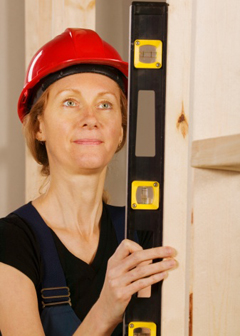What Carpenters Do

Carpenters work with many different types of tools.
Carpenters construct and repair building frameworks and structures—such as stairways, doorframes, partitions, and rafters—made from wood and other materials. They also may install kitchen cabinets, siding, and drywall.
Duties
Carpenters typically do the following:
- Follow blueprints and building plans to meet the needs of clients
- Install structures and fixtures, such as windows and molding
- Measure, cut, or shape wood, plastic, and other materials
- Construct building frameworks, including walls, floors, and doorframes
- Help erect, level, and install building framework with the aid of rigging hardware and cranes
- Inspect and replace damaged framework or other structures and fixtures
- Instruct and direct laborers and other construction helpers
Carpenters are one of the most versatile construction occupations, with workers usually doing many different tasks. For example, some carpenters insulate office buildings; others install drywall or kitchen cabinets in homes. Those who help construct tall buildings or bridges often install the wooden concrete forms for cement footings or pillars. Some carpenters erect shoring and scaffolding for buildings.
Carpenters use many different hand and power tools to cut and shape wood, plastic, fiberglass, or drywall. They commonly use hand tools, including squares, levels, and chisels, as well as many power tools, such as sanders, circular saws, nail guns, and welding machines. Carpenters fasten materials together with nails, screws, staples, and adhesives, and do a final check of their work to ensure accuracy. They use a tape measure on nearly every project because proper measuring increases productivity, reduces waste, and ensures that the pieces being cut are the proper size.
The following are examples of types of carpenters:
Residential carpenters typically specialize in new-home, townhome, and condominium building and remodeling. As part of a single job, they might build and set forms for footings, walls, and slabs, and frame and finish exterior walls, roofs, and decks. They also frame interior walls, build stairs, and install drywall, crown molding, doors, and cabinets. In addition, residential carpenters may tile floors and lay wood floors and carpet. Fully trained construction carpenters can easily switch from new-home building to remodeling.
Commercial carpenters typically remodel and help build commercial office buildings, hospitals, hotels, schools, and shopping malls. Some specialize in working with light-gauge and load-bearing steel framing for interior partitions, exterior framing, and curtain wall construction. Others specialize in working with concrete forming systems and finishing interior and exterior walls, partitions, and ceilings. Most commercial carpenters perform many of the same tasks as residential carpenters.
Industrial carpenters typically work in civil and industrial settings, where they build scaffolding and create and set forms for pouring concrete. Some industrial carpenters build tunnel bracing or partitions in underground passageways and mines to control the circulation of air to worksites. Others build concrete forms for tunnels, bridges, dams, power plants, or sewer construction projects.




No comments:
Post a Comment